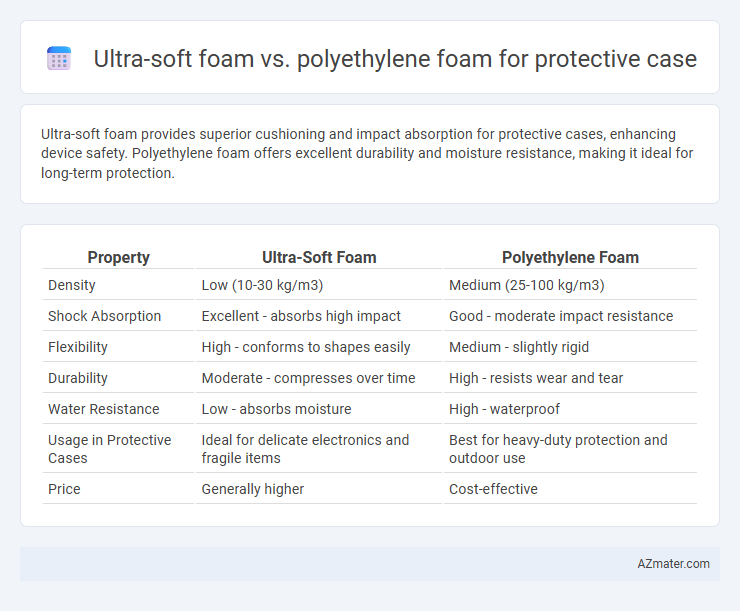Ultra-soft foam provides superior cushioning and impact absorption for protective cases, enhancing device safety. Polyethylene foam offers excellent durability and moisture resistance, making it ideal for long-term protection.
Table of Comparison
| Property | Ultra-Soft Foam | Polyethylene Foam |
|---|---|---|
| Density | Low (10-30 kg/m3) | Medium (25-100 kg/m3) |
| Shock Absorption | Excellent - absorbs high impact | Good - moderate impact resistance |
| Flexibility | High - conforms to shapes easily | Medium - slightly rigid |
| Durability | Moderate - compresses over time | High - resists wear and tear |
| Water Resistance | Low - absorbs moisture | High - waterproof |
| Usage in Protective Cases | Ideal for delicate electronics and fragile items | Best for heavy-duty protection and outdoor use |
| Price | Generally higher | Cost-effective |
Introduction to Protective Case Foam Materials
Ultra-soft foam and polyethylene foam are two primary materials used in protective case manufacturing, each offering distinct benefits tailored to different protection needs. Ultra-soft foam provides superior cushioning and impact absorption, making it ideal for delicate electronics and sensitive equipment. Polyethylene foam, known for its high durability and moisture resistance, delivers excellent structural support and long-term protection in rugged environments.
What is Ultra-soft Foam?
Ultra-soft foam is a highly pliable and cushioning material designed to absorb shock and prevent damage to delicate items within protective cases, offering superior impact resistance compared to standard polyethylene foam. Renowned for its lightweight and flexible properties, ultra-soft foam easily molds to the shape of the stored item, providing enhanced protection against scratches and vibrations. Unlike polyethylene foam, which is denser and less adaptable, ultra-soft foam delivers an optimal balance of softness and durability for safeguarding sensitive equipment.
What is Polyethylene Foam?
Polyethylene foam is a closed-cell, lightweight, and durable material widely used in protective cases for its excellent impact absorption and moisture resistance. Unlike ultra-soft foam, polyethylene foam provides firmer cushioning, making it ideal for safeguarding delicate electronic devices, instruments, and fragile equipment during transport. Its chemical resistance and ability to withstand repeated compressions ensure long-lasting protection compared to ultra-soft foam which is more prone to wear and deformation.
Key Differences Between Ultra-soft and Polyethylene Foam
Ultra-soft foam offers superior cushioning and impact absorption, making it ideal for delicate or sensitive items in protective cases. Polyethylene foam provides higher density and rigidity, delivering excellent structural support and resistance to compression under heavy loads. The key differences lie in ultra-soft foam's flexibility and softness versus polyethylene foam's durability and strength.
Cushioning Performance Comparison
Ultra-soft foam offers superior cushioning performance due to its high elasticity and energy absorption, making it ideal for protecting delicate and sensitive items from impacts. Polyethylene foam provides moderate cushioning with better resistance to compression and moisture, suitable for heavier, more durable protective cases. Choosing between these foams depends on the balance between impact absorption and material durability required for specific protective case applications.
Durability and Longevity of Each Foam Type
Ultra-soft foam offers superior cushioning but tends to compress and degrade quicker under frequent impact, limiting its durability and longevity in protective cases. Polyethylene foam provides excellent resilience and retention of shape over time, making it a more durable choice for cases requiring long-term protection. Its closed-cell structure resists moisture, chemicals, and wear, significantly extending the lifespan compared to ultra-soft foam.
Impact Absorption Efficiency
Ultra-soft foam offers superior impact absorption efficiency due to its low density and high compressibility, which effectively dissipates shock forces during drops or collisions. Polyethylene foam provides moderate impact resistance with a firmer structure, making it more suitable for heavy-duty protection but less efficient in absorbing sudden, high-impact shocks. Selecting ultra-soft foam enhances cushioning performance in lightweight protective cases, while polyethylene foam prioritizes durability and structural support.
Weight and Handling Considerations
Ultra-soft foam offers superior cushioning with minimal weight, making it ideal for lightweight protective cases requiring delicate handling. Polyethylene foam is denser and slightly heavier but provides enhanced structural support and resistance to compression in protective cases. Choosing between these foams depends on balancing the need for lightweight portability with the necessity of firmer protection and durability during handling.
Cost-effectiveness and Value
Ultra-soft foam offers enhanced cushioning and shock absorption, making it ideal for high-value or fragile items, but it generally comes at a higher price point than polyethylene foam. Polyethylene foam provides a cost-effective solution with good durability and sufficient protection for less fragile products, ensuring long-term value without significant investment. Choosing between the two depends on balancing the level of protection required against budget constraints and the specific application's sensitivity.
Choosing the Best Foam for Protective Cases
Ultra-soft foam offers superior cushioning by absorbing high-impact shocks, making it ideal for delicate or electronic items in protective cases. Polyethylene foam provides excellent durability and resistance to moisture, chemicals, and compression, suitable for heavy-duty protection and prolonged use. Selecting the best foam depends on the specific protection needs, balancing softness for impact absorption with the resilience required for environmental resistance.

Infographic: Ultra-soft foam vs Polyethylene foam for Protective case
 azmater.com
azmater.com